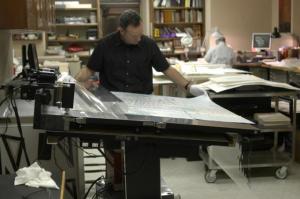Collections Care

Collections Care maintains and preserves collection materials that are housed within the general collections of The New York Public Library’s research libraries, and are available at from the general reading rooms at each location. Collections Care focuses two areas: new collection items that need to be prepared for use; and in-use items requiring repair and protective housing. Collection Care’s ability to stabilize and treat collections in-house makes it possible to return items to public use in a timely manner while retaining significant structural, artifactual and informational aspects of collection material.
The Collections Care program staff are responsible for:
- Performing collection condition assessments
- Performing physical treatments to repair and stabilize collection materials for continuous and ongoing use
- Constructing custom protective enclosures to house and safeguard collection items
- Leading disaster response and recovery for Library collections
- Advising the Library regarding commercial library binding
- Managing programs for the mass deacidification of collection materials
Within the Collections Care lab, staff perform a variety of preservation treatments such as:
- Mending paper
- Humidifying and flattening of paper-based products
- Replacing or mending book covers
- Reconstructing book spines
- Reproducing severely damaged or missing pages
- Permanently attaching or creating pockets for loose items in books
- Consolidating book’s text blocks
- Deacidifying individual collection items
- Cleaning and remediating mold-damaged collection items
Collections Care collaborates with staff in Library divisions to assess individual housing needs of items. The lab produces a variety of housings, the most common include custom-made boxes for all types of collection materials, encapsulation for flat items, and protective dust jackets for books.

Using a Kasemake digital cutting machine, the lab is able to produce many thousands of custom boxes and protective enclosures per year. Depending on the size and complexity of collection items receiving an enclosure, the lab produces between 60-90 enclosures per day. Staff from the research centers electronically submit measurements and bibliographic details for custom enclosures via a web-based form, eliminating the need for the collections to travel to the lab.
Fragile collection item such as a poster, a map or, individual document, sometimes require additional physical protection to make them accessible. the Library’s custom-built ultrasonic welders help with this efforts. These machines allow for collection items to be encapsulated (sandwiched) between two layers of chemically inert polyester. The polyester is sealed ultrasonically on all four edges, creating a new housing for the item contained within. For collection items that are acidic, they are either deacidified before encapsulation, or an alkaline buffered sheet of paper is placed behind the item inside the encapsulation.
Books with photographic or elaborately designed book covers or dust jackets may require additional protection from wear and tear. Collections Care employs a system that creates clear book covers made of chemically inert plastic to achieve this protection. Pre-cut polyethylene covers are snugly sealed (welded) to the dimensions of the book’s spine and covers. These custom book jackets are also used for in-use collection items that have historically significant covers with minor damage or leather book covers that exhibit deterioration and desiccation known as “red rot”.

In addition to performing deacidification of collection items on an individual basis, Collections Care manages the Library’s mass deacidification efforts. Mass deacidification is performed by an external vendor that specializes in this form of treatment. The process selected by the Library is achieved by securely suspending multiple books in a tank and then agitating the books in a non-aqueous chemical solution that raises the pH level of the paper by neutralizing existing acids and depositing an alkaline buffer (creating an alkaline reserve). The process hinders further deterioration of the paper.
The commercial library binding and shelf preparation program is a shared responsibility. Collections Care collaborates with BookOps staff in an advisory role to set binding specifications and quality control standards, and also to assist in managing vendor relationships.
Collections Care and Field Services ensure appropriate disaster recovery supplies and equipment are available throughout Library sites for collection emergencies. Staff also lead participation in cleanup and recovery efforts and treat affected items.
Preservation Blogs
- Conservation Treatment of Hendrick Doncker’s Zee-atlas from 1660; Or, How an Atlas Gets Stressed, and What Book Conservators Do About It
- Inside the Conservation Lab: Three-Dimensional "Seal-Print"
- Preservation Week 2015: Taking Care of Your Collections at Home
- Time Machine: Interstitial Moment, Video Stockholm Syndrome